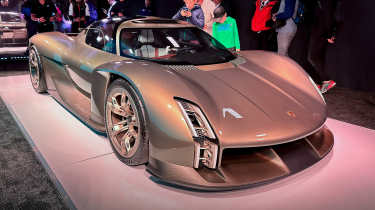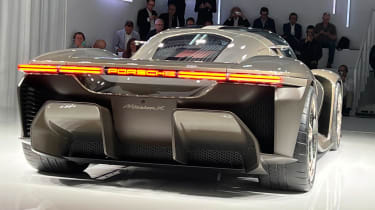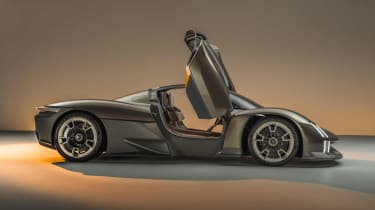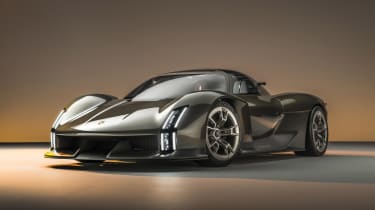1500bhp Porsche Mission X hypercar makes public debut
Porsche’s 75th birthday present to itself is an all-new electric hypercar with its sights set on being the fastest road-legal car around the Ring
With Le Mans celebrating its centenary and Porsche its 75th anniversary, you didn’t expect anything else from the German icon than a concept car inspired by some of the most successful race cars of the last century, did you? With its LED eyes set on being the fastest road-legal car to lap the Nürburgring Nordschleife, the Mission X will be Porsche’s most extreme road car ever and will be on sale in 2027.
So while Mission X is a concept for now, Porsche rarely displays such a thing that doesn’t make production, and not only is it designed to be the fastest road car on the Ring, it will also generate more downforce than the new 911 GT3 RS, charge twice as quickly as a Taycan S and produce 1bhp per kilo.
Inspired by the supercar icons created in Stuttgart, including the 959, Carrera GT and 918 Spyder, the Mission X blends the company’s motorsport design and heritage with tomorrow’s technology and was bought to life in just nine months, the show car finished the Thursday before the 24 Hour race weekend.
Measuring 4.5 metres long with a 2.73 metre wheelbase, the Mission X has a footprint that matches the Carrera GT and 918’s and will be built on a new electric hypercar architecture underpinned by a new carbon fibre exoskeleton that will provide a foundation for future potential products from within the Porsche empire, such as Bugatti’s next generation of hypercars. The monocoque is an adapted version of the 918 Spyder's, which traces its roots back to the RS Spyder LMP2 racer car, but a new monocoque is to be designed for the production car.
It will eventually become a production-ready hypercar in 2027, with a Porsche executive telling at evo 'It's not decided yet that it's a green light (for production). But it's not a red' during a preview for existing Carrera GT and 918 Spyder customers held during the Le Mans 24 Hour race weekend.
At 1.2 metres high (nearly 2 metres when the doors are open) it’s as low as the racing snakes its design is inspired by. From the 906 and 908 racers, to the 917 and beyond, Porsche head of style Michael Mauer and his team have immersed themselves in the company’s rich back catalogue of endurance racers to create a homage to those legendary machines. With hinged doors attached to the A-pillar and roof, a glass dome canopy and 20 and 21-inch wheels aerodynamically designed to aid brake cooling, the Mission X is a future racer with roots inspired by the successes of the past. The body is all carbonfibre.
The Mission X’s development will see Porsche’s engineering team work closely with Rimac Automobili – in which it took a 45 percent stake in 2022 – not only on the car’s chassis design but also its 900-volt battery and motor technology and architecture too. The Mission X is not a further evolution of the Rimac Nevera hypercar but will be an all-new machine.
Powered by a centrally mounted battery mounted in the middle of the car as per the Lotus Evija with drive arriving at each wheel via individual motors, with a total output expected to be in the region of 1500bhp to power the 1500kg machine. The batteries will be developed by Porsche’s new specialist battery company Cellforce, a joint venture with battery specialist Customcells that was established in 2021 to focus on battery cell technology for motorsport and bespoke vehicle applications.
Inside, like many a concept car, the Mission X showcases potential new materials and design details. The driver's seat is individually scanned and manufactured in CFPR to fit he driver perfectly, and in the concept is finished in Kalahari grey in contrast to the Andaluz brown of the passenger seat. Each individual leather pad is also adapted to the driver's requirements, with the top pad removable for when wearing a crash helmet and the pedals are adjustable.
The steering wheel is pure LMP hypercar in terms of design, with a single curved screen ahead. The wheel feature four mode switches for: PASM damper setting, driving mode, traction and stability setting and the PTV+ to control the car's active aero. For added jewellery the steering column is exposed. In front of the passenger is an additional screen complete with a old-school style stop watch.
Porsche has a number of objectives for the Mission X. Top of the to-do list is to set the fastest lap time of the Nordschleife for a road-legal car, a record currently held by the Mercedes-AMG One with a time of 6.35:18. The quickest lap by an EV is held by VW’s ID.R with a time of 6.05:34, while Porsche holds the outright lap record of 5.19:55, set by the 919 Evo.
The Mission X will also generate ‘significantly more’ downforce than the current 911 GT3 RS, which produces 860kg at 177mph, so expect around 1000kg of the magic stuff pushing this fully charged hypercar into the surface. Aiding this downforce is an adaptive rear wing. On a more practical side, Porsche has said its EV hypercar will charge at twice the speed of the current Taycan S; the electric supersaloon takes 22.5 minutes to go from five to 80 percent charge using an 800-volt charger.
Porsche isn’t one to show concepts and then simply retire them to its museum, although in 2017 the company did experiment with producing a 'street' version of its 919 Le Mans winner. Using the same carbon chassis and hybrid powertrain a concept study was produce, but with a team of mechanics required 45 minutes prior to any driving just to start the car the project was parked.
The expectation is that Mission X will take a similar four-year period of development that the Mission E required to go from motor-show crowd-puller to Taycan sales success. The public had its first opportunity to see the concept at Le Mans during the race weekend, with its public debut coming at the Goodwood Festival of Speed.












